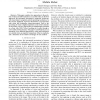Free Online Productivity Tools
i2Speak
i2Symbol
i2OCR
iTex2Img
iWeb2Print
iWeb2Shot
i2Type
iPdf2Split
iPdf2Merge
i2Bopomofo
i2Arabic
i2Style
i2Image
i2PDF
iLatex2Rtf
Sci2ools
ICRA
2007
IEEE
2007
IEEE
A Comparison of Two Approaches for Vision and Self-Localization on a Mobile Robot
Abstract— This paper considers two approaches to the problem of vision and self-localization on a mobile robot. In the first approach, the perceptual processing is primarily bottom-up, with visual object recognition entirely preceding localization. In the second, significant top-down information is incorporated, with vision and localization being intertwined. That is, the processing of vision is highly dependent on the robot’s estimate of its location. The two approaches are implemented and tested on a Sony Aibo ERS-7 robot, localizing as it walks through a color-coded test-bed domain. This paper’s contributions are an exposition of two different approaches to vision and localization on a mobile robot, an empirical comparison of the two methods, and a discussion of the relative advantages of each method.
| Added | 03 Jun 2010 |
| Updated | 03 Jun 2010 |
| Type | Conference |
| Year | 2007 |
| Where | ICRA |
| Authors | Daniel Stronger, Peter Stone |
Comments (0)

